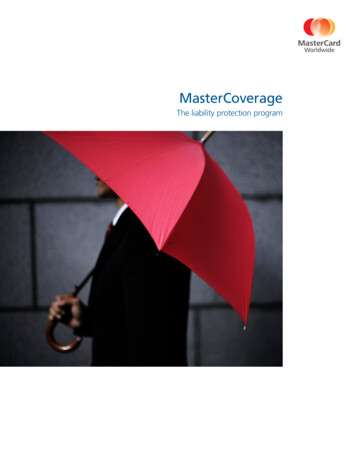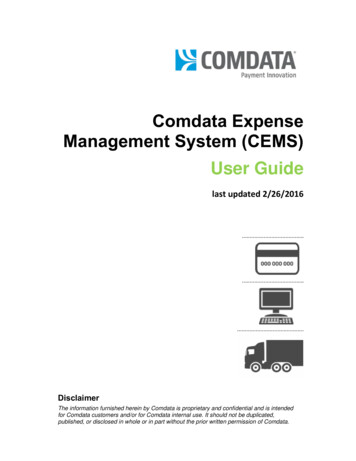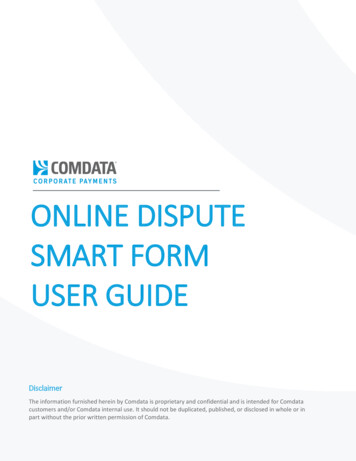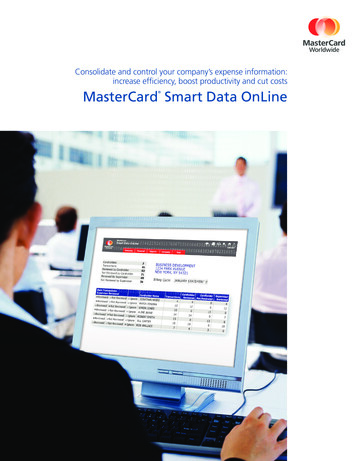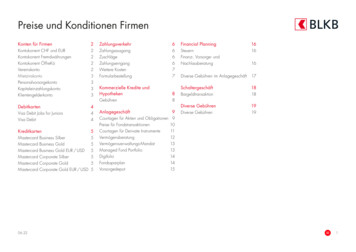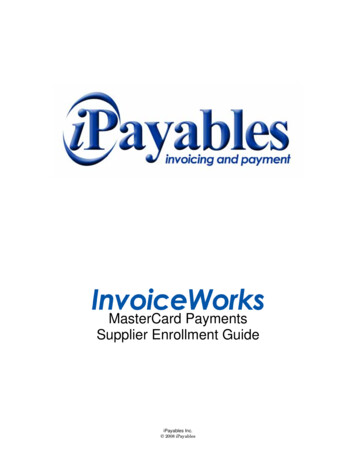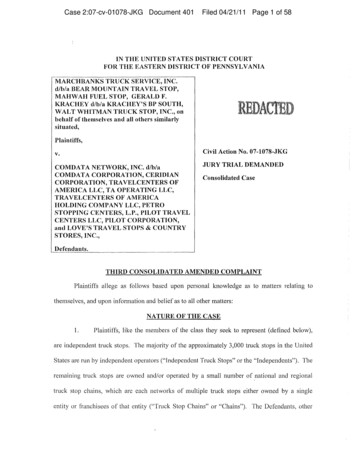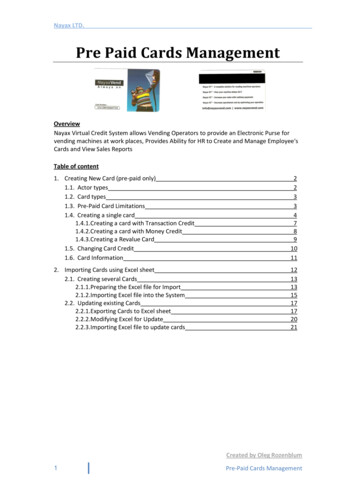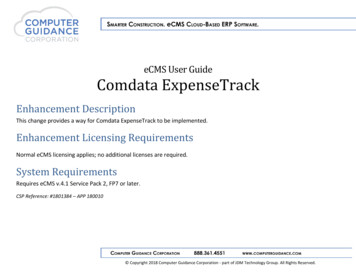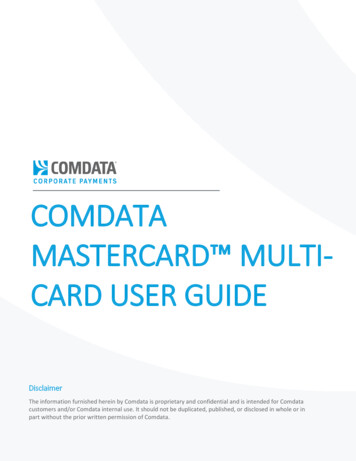
Transcription
COMDATAMASTERCARD MULTICARD USER GUIDEDisclaimerThe information furnished herein by Comdata is proprietary and confidential and is intended for Comdatacustomers and/or Comdata internal use. It should not be duplicated, published, or disclosed in whole or inpart without the prior written permission of Comdata.
Table of ContentsOverview . 5Mastercard Multi-Card Best Practices . 6Dispute Fraudulent Transactions . 9Filing a Dispute . 9Using the Online Dispute Smart Form . 10Fraud Dispute Frequently Asked Questions . 18Cardholder Identification Data (CID) . 19Using iConnectData (ICD) . 20Logging into ICD . 21Checking Available Credit . 39Performing Codeword Maintenance . 40Copying and Deleting User Profiles. 43Ordering Virtual Cards for Travel . 47Displaying Real-Time Transaction History . 59Pay an Invoice . 68Running Reports. 78Using the Resource Center . 82Appendix . 83Sample Cardholder Email Communication . 83Cardholder Agreement . 84
Mastercard Multi-Card User GuideRevision TableDateVersionAuthorNotes08/22/201706/11/2019Ver 1.3Ver 1.4Steven HarrisSteven HarrisInitial document distributedChanged “MasterCard” to “Mastercard”08/26/2021Ver 1.5Steven HarrisUpdated several components and changed thedocument title to Mastercard Multi-Card User GuideComdata Confidential and Proprietary4
Mastercard Multi-Card User GuideOverviewComdata offers the ability to add a Purchasing and Travel & Entertainment (T&E) program to yourbusiness all under one roof with the Comdata Mastercard Multi-Card. With this program, you havethe choice of using the card solely for Purchasing, T&E, fuel, or all of the above. By adding all theseservices to one card, you can manage your transactions, invoices, and data from one location.Comdata can help you set up usage limits, such as the total spendable amount, location, and times (offhours blocking) when the card can be used. In addition, using a Comdata Mastercard Multi-Card meansyou can automatically reconcile transactions, reduce fraud, gain in-depth insight into your businessspending, and even earn monthly rebates on every dollar spent.Some other benefits include: Unparalleled Global Acceptance. The Mastercard Multi-Card is backed by Mastercard, providingyou security and universal acceptance at nearly 40 million merchants around the world. Earn Money Back on Spending. Every dollar spent using your Comdata Mastercard Multi-Cardearns monthly rebates for your business. Alerts and Notifications. As part of using a Multi-Card, Comdata offers Alerts and Notifications(A&N), an enhanced fraud detection and management program that helps you and yourcardholders quickly and efficiently capture and reduce exposure to credit card fraud. Control and Easy Reconciliation. Comdata will work with you to set up card controls that limitemployees not only from making purchases at certain times and locations, but also frompurchasing certain products and amounts of products. By making purchases with a ComdataMastercard Multi-Card, you can automatically reconcile transactions, reduce fraud, and gain betterinsight into your business spending. Mastercard Easy Savings. An automatic rebate program that enables participating merchants toprovide rebates eligible to Mastercard small business cardholders registered in the program. Cash Wallet. An optional feature that allows you to load one-time funds to a cardholder’s balance.Cash Wallet is especially useful with travel and purchasing programs to pay per diems or reimburseexpenses for cardholders. Cardholder Identification Data. Cardholders can securely call Comdata to inquire about their cardsby using their date of birth or Social Security Number to verify their identity. Virtual Card for Travel. Simplify the booking process by using electronic virtual card numbers to payfor travel related expenses, such as rental cars, airline tickets, and hotel rooms.Comdata Confidential and Proprietary5
Mastercard Multi-Card User GuideMastercard Multi-Card Best PracticesAlthough it is a good business practice in any credit card program to mitigate as much fraud aspossible, understand that no matter how well designed your program is, fraud may still occur.However, you can take steps to make your Comdata Mastercard Multi-Card program as fraud resistantas possible. See below for a list of best practices that will aid you in your fight against fraud.1. Take advantage of Alerts and Notifications (A&N).Protecting your Mastercard cardholders from fraud and identity theft is a top priority at Comdata.That’s why we offer the Comdata A&N program to help you improve security around your Comdatacards and minimize risk. With Comdata A&N, your cardholders receive text messages whenComdata’s internal risk analysis system identifies a suspicious transaction. Then, your cardholdercan reply to the message confirming if the transaction was fraud. If fraudulent, the card goes into alocked-down state and each additional transaction is declined. However, the cardholder will receivea text message with each declined transaction allowing them to override the declined authorization.If they override, they can swipe their card again and continue the transaction, only if the transactionis for the same amount and from the same merchant. If the cardholder receives a declinedtransaction they don’t recognize, there’s no need to respond as the transaction was not authorized.Extensive documentation on A&N is available in Comdata’s ICD Resource Center.2. Design policies and procedures that are detailed, updated regularly, and reflect the roles andresponsibilities of your program.Firm policies and procedures are the foundation of a fraud-resistant Multi-Card program. Make surethese policies and procedures are detailed and spell out the accountabilities and responsibilities ofcardholders and those monitoring card usage. If the full details of the program (monitoring,specified usage, etc.) are not clearly defined, fraud is more likely to occur.3. Appoint a Program Administrator with responsibility and authority over your program.A Program Administrator can ensure cardholders are trained, monitor card usage, and assure that allaspects of the program are kept up to date and reflect all available technology and managementcontrols. Program Administrators are also responsible for distributing cards, training (and retraining)cardholders and transaction reconcilers, and monitoring for unintentional personal use or obviousmisuse. Furthermore, Program Administrators are responsible for approving officials who providedaily oversight for the program, assuring contract terms are fulfilled by both the organization andthe card providers, and regularly reviewing provider services for Mastercard Multi-Cards.4. Implement a detailed written policy requiring the signature of the cardholder and their supervisorto reinforce responsibility and improve accountability.The cardholder’s supervisor is accountable for how the card is used.(continued on next page)Comdata Confidential and Proprietary6
Mastercard Multi-Card User GuideTherefore, having the supervisor sign a written policy for card use by the cardholder reminds themthat they are accountable for and must monitor each cardholder purchase. Each level of monitoringinstituted in your card program is another method of minimizing misuse and abuse of your cards.5. Designate and communicate roles and responsibilities for transaction reconcilers and approvingofficials.A prevalent error that occurs in many credit card programs is companies allowing cardholders tohave subordinates responsible for reconciling and approving their own transactions. Reconcilers (aperson who gathers supporting documentation and posts transactions to a financial system) andapprovers (a person responsible for approving cardholder transactions) should not be under thecardholder’s supervision.These roles must be held by individual people who can make judgements on appropriate card usewithout the cardholder’s direction. Document specific responsibilities for each person involved inthe card use and monitor processes so that all transactions receive an appropriate level ofscrutiny, and ensure approval and responsibility are properly segregated.6. Establish card limits to reduce excessive or inappropriate use.Some companies usually start off with low transaction limits but eventually realize they can reducepurchasing costs and increase incentive revenues by increasing their limits to the highest levelpossible. Unfortunately, this causes companies to raise limits to unnecessarily high levels. A goodrule to follow is to provide card limits that slightly exceed the highest actual purchase in thepreceding year by a cardholder. Define limits by the employee or employee class use, not byestablishing blanket limits for all cards. Blanket limits provide cardholders considerably morepurchasing power than they will need or use, which increases the risk of abuse and misuse.7. Conduct mandatory face-to-face training to new cardholders and face-to-face or online refreshertraining every two years for existing cardholders.Require face-to-face training for new cardholders before issuing them a card and annual orbiannual training for all existing cardholders. In-person training ensures emphasis is applied duringthe initial training and allows new cardholders to ask questions. Most cardholders will use theircards appropriately if they receive proper instruction from the beginning. Reserve computer orweb-based training for only subsequent trainings.8. Require original receipts for every purchase.Every photocopy accepted in support of a credit card program is an increased risk of fraud orabuse. In today’s world of technology, obtaining and tracking receipts is difficult, but should still beof utmost importance. If a receipt is absent, require the cardholder to provide every documentavailable to support the transaction.(continued on next page)Comdata Confidential and Proprietary7
Mastercard Multi-Card User GuideFor web purchases, require cardholders to provide a screen shot of the order confirmation screenand email (if received). Any receiving documentation or packing slips included with deliveredpurchases should also be included. Do not approve or reconcile a purchase without detailedsupporting documentation that delineates the entire amount charged, as well as the specificbusiness purpose of the purchase.9. Require electronic transfer of cumulative data from the card-services provider for data mining andanalysis based on known risk factors.The creation of comprehensive software to analyze databases for transaction anomalies hasincreased the need of access to electronic data and improved monitoring of all types of transactions.Using software to identify anomalies such as split transactions (multiple transactions designed tocircumvent card limits), over-limit purchases, unusual transaction patterns, use of non-standardvendors for standard purchases, and even-dollar transactions at or just below threshold levels willallow more efficient and effective monitoring, prevention, and detection of potential misuse.Defining these anomalies is key to electronic data analysis of card activity. Assuring that the cardservice provider has the ability to produce Level 1, 2, and 3 transaction information is critical to thisanalysis process. This information breaks each transaction down by MCC (Merchant Category Code),type of service, vendor identification, and vendor corporate status to assure operational, financial,and tax related information is available to the organization for analysis and use.10. Provide a hotline process to report suspected abuse.In most fraud incidents, at least one person knew or suspected the fraud, but didn’t know how toreport their suspicion. The lack of a defined process to report suspected fraud can be a contributingfactor. Provide a confidential process for individuals to report suspected fraud and card abuse, andpublicize the process through training and ongoing communication from the Program Administrator.11. Establish meaningful and enforced policies governing consequences for misuse.Consequences for misuse must be real, known, and enforced. Treat all card misuse as a violation,and consider the proven use of a card for personal purchases as theft. Prosecute the individual andpublicize the prosecution. Not punishing or publicizing the criminal act opens the door for morefraud. Enforcing and promoting consequences can significantly reduce the likelihood of fraud.12. Establish recurring audits to evaluate compliance with program policies and requirements.Although routine monitoring processes are best handled by each operating unit’s management,regular surprise audits of card usage, combined with data mining and analysis of usage anomaliesand transaction information, provide in-depth oversight that can significantly prevent fraud. You canuncover fraud during a routine audit of the unit’s card documentation that disclosed irregularities inthe explanations for nonstandard transactions and documentation. Without the audit, the fraudmay have continued indefinitely. If your program generates sufficient revenue in incentives, thisaudit activity can be part of your staff, funded by the incentive funds.Comdata Confidential and Proprietary8
Mastercard Multi-Card User GuideDispute Fraudulent TransactionsIn an effort to streamline Mastercard disputes, Comdata has developed a new Online Dispute SmartForm within iConnectData (ICD).The Online Dispute Smart Form is dynamic in the sense that it generates a unique form with requiredinformation based on your selected reason for dispute. These specific forms can help you and Comdataunderstand the necessary information needed to file your dispute. You can also download a PDF of thedispute after it is submitted for your records.This document is intended to walk you through filing a dispute through ICD using each of the uniqueforms.Note: If you are the company administrator, you may submit dispute forms through the secure ICDwebsite on the cardholder’s behalf without obtaining a signature. Doing so confirms that you have arelationship with the cardholder and that the transaction is being disputed by the authorized user.Submitting the dispute via a secure site satisfies the Mastercard signature requirements.Please note it is important that you notify us about any transaction disputes within 60 days of thesuspicious charge.The following verbiage regarding this rule is located on each form: “We certify that this informationwas obtained via a secure website, and is being disputed by the authorized user.”Filing a DisputeIf a cardholder suspects fraudulent activity on their card, instruct them to follow these steps:1. Call the Comdata Contact Center at 1-800-282-7496, which is open 24/7/365.2. Let the Comdata agent know they suspect fraudulent charges on their card.a) The Comdata agent will block the card and ask the cardholder to contact their ProgramAdministrator (you), who can order the new card.Note: Once Comdata is notified of the suspected fraud, then the customer is no longer liablefor new fraudulent charges. If you are registered with the Alerts and Notifications program,then the Agent will offer to place the cardholder’s card in a “hobble home” status, so they arenot without access to a card if they are travelling.3.The Comdata Agent will then ask the cardholder to contact you to file a dispute and order a newcard.a)Be aware when a new card is issued so you can update your expense management systemwith the new card number associated with the employee.(continued on next page)Comdata Confidential and Proprietary9
Mastercard Multi-Card User Guideb)Filing a dispute online typically takes a few minutes and saves a cardholder from having to fillout any documentation and fax it to Comdata. This also ensures customers have a Dispute IDthat verifies that the fraudulent dispute was filed.c)Filing a dispute also inserts an additional control around the validity of the dispute andensures it is valid, as invalid disputes can quickly become your responsibility.Once the dispute is processed in ICD, Comdata will initiate the chargeback process with themerchant involved in the dispute. At this point, you can do the following: Enroll the cardholder in Alerts and Notifications. Identify repeat-offenders whom might be using the card inappropriately.Using the Online Dispute Smart FormThe following steps demonstrate how to file a dispute using the Online Dispute Smart Form in ICD.1. On the ICD home page, select Manage Transactions Real Time Transaction History.Comdata Confidential and Proprietary10
Mastercard Multi-Card User Guide2. On the transaction history page,enter the required information torun a report. Note that only Postedtransactions can be disputed. ClickSubmit when finished.3. Select the checkbox next to the transaction(s) you want to dispute. Then, click Initiate Dispute.Note: You cannot dispute the same transaction more than once. If your dispute reason is “I did notauthorize or participate in this/these transaction(s)” you can dispute multiple transactions for onlyone card.Comdata Confidential and Proprietary11
Mastercard Multi-Card User Guide4. Select I did not authorize or participate in this/these transaction(s) and then click Dispute.5. The Online Dispute form opens with your contact information populated at the top of the page.Complete each field as necessary. Required fields are denoted by a red asterisk.Comdata Confidential and Proprietary12
Mastercard Multi-Card User GuideThis specific dispute form provides three options: My card was lost/stolen at the time of the disputed transaction. Select this option to fill outadditional information as to the circumstances surrounding the fraudulent card use, (date cardwent missing, start date of unauthorized transactions, if police were notified, etc.). Thisinformation helps Comdata better understand the situation, so appropriate action can be taken. My card was in my possession at the time of the disputed transactions. Select this option if thecard was in your possession at that time of the unauthorized transaction. This option can also beused if the card number was used fraudulently while the card was in your possession. The card was misused by the employee assigned to the card. Select this option if an employeeor authorized user caused the fraudulent transaction(s). Then, specify if the employee orauthorized user was terminated and the date of termination.Comdata Confidential and Proprietary13
Mastercard Multi-Card User Guide6. After you enter all required information, click Submit at the bottom of the page.7. A PDF with the dispute details will display; save the PDF for your records. A confirmation emailwill also be sent to your ICD email address.Note: Take note of the following in the generated PDF: If multiple disputes are filed on one card, a total recon and posted amount will display at thebottom of the PDF. The Dispute ID displays in the top right corner of the PDF. Take note of this and use theDispute ID to identify and track the dispute. If there are multiple pages on the PDF, the Dispute ID will display on each page.Comdata Confidential and Proprietary14
Mastercard Multi-Card User GuideSearch for a Filed DisputeICD’s Real-time Transaction History allows you to locate and review submitted transaction disputes.1. On the Transaction History page, enter therequired information to run a report. Tosearch for disputed transactions, followthese tips:a) To search for a specific dispute, selectDispute ID from the Search By radiobuttons, then enter the correspondingdispute ID in the Search Value field.b) To search for multiple disputetransactions across a date range, selectDisputed from Transaction Status.Then, select your date range.Note: Disputed transactions will alsodisplay on the transaction historyreport if All or Posted is selected fromTransaction Status.2. Click Submit to display the transaction history report in your browser. Click Download to save thetransaction history report in Excel format.Download ViewComdata Confidential and Proprietary15
Mastercard Multi-Card User Guide3. A dispute ID link displays in the left column for transactions disputed electronically. Also, theTransaction Status column will display Disputed. Click the disputed ID link to open a copy of theconfirmation PDF.4. If you have not already, save this document for your records.Comdata Confidential and Proprietary16
Mastercard Multi-Card User GuideDispute Confirmation EmailYou will receive a confirmation email for each dispute you submit. See below for an example.Confirmation emails contain a link to the PDF form and details on your dispute, such as the number ofdays to process and reconciliation information.Comdata Confidential and Proprietary17
Mastercard Multi-Card User GuideFraud Dispute Frequently Asked Questions1. How long do I have to enter the dispute for a fraudulent transaction?You have 60 days from the bill/invoice date of the transaction to enter a fraud dispute.2. Why can’t Comdata enter my cardholder’s dispute?Mastercard regulations require cardholders to certify they did not participate in a fraud transaction.To ease the process for cardholders, you can act on their behalf and certify that the cardholder didnot participate via the Online Dispute Smart Form in ICD.3. What information can I use to track my dispute?Once you enter a dispute in ICD, you will receive a Dispute ID which can be used to identify thedispute until it is resolved.4. What communication will I receive after the dispute is filed?If the merchant represents the transaction, you may receive a progressive letter completed byComdata’s dispute department that reaffirms the dispute. If you want to continue with thedispute, the letter must be signed and returned to Comdata within eight days indicating yourpreference to continue the dispute.5. What if I suspect a cardholder misuses their card and are claiming fraud to cover their tracks?Comdata’s process allows you to always stay aware of transactions under dispute. This allows fullinsight into any potential cardholder misuse in order to reduce potential liability and loss.6. Should I replace the card which has potential fraudulent activity?If a cardholder states they have fraudulent charges, block the card and replace it to prevent anyfurther transaction activity. Your account manager can also assist with the replacement process.7. What steps should I take after I replace a card?Replacing a card has several downstream dependencies. The new card must be entered into thecardholder’s expense management tool. In addition, if a card is replaced it must be enrolled intothe Alerts & Notifications system to maximize Comdata’s fraud prevention tools. You, the ProgramAdministrator, are best positioned to make these changes and control your program.8. Can I call the Contact Center to help me with fraudulent disputes?The Contact Center has the ability to block the card in order to prevent any further fraud charges.However, the dispute entry and card replacement should be done via ICD.Comdata Confidential and Proprietary18
Mastercard Multi-Card User GuideCardholder Identification Data (CID)When cardholders call Comdata for assistance with their card, they are required to verify their identity.To do so, they can provide one of the following to the Comdata agent: Last 4-digits of Social Security Number Date of Birth (month, date, year)Please note that Comdata agents can help cardholders with only the following information and issues: Transaction History Card Declines General program questions Available spend amount Reporting a lost or stolen card Cash Wallet supportFor any information or issues outside of those listed above, the cardholder will need to contact you,their Program Administrator. As a Program Administrator, you can send this information to Comdataso we can have it on file for reference. Ask your Comdata representative for a PS14 file, which willallow you to send us your cardholder’s information.Comdata Confidential and Proprietary19
Mastercard Multi-Card User GuideUsing iConnectData (ICD)ICD is Comdata’s secure, self-service web portal for performing account management tasks, such asordering cards, checking credit availability, running reports, and much more. The features in ICD aredesigned to provide self-service account management, which can reduce the need to contact aCustomer Service agent.See below for a list of pertinent tasks on using your account. For more information on the manyfeatures available in ICD, see the ICD Resource Center. Logging into ICDChecking Available CreditPerforming Codeword MaintenanceCopying and Deleting UsersOrdering Virtual Cards for TravelRunning ReportsAccessing and Using the Resource CenterComdata Confidential and Proprietary20
Mastercard Multi-Card User GuideLogging into ICDOnce you receive the Welcome Email, you can sign in to ICD at https://w6.iconnectdata.com/Login/initand access all of your available features.1. Enter your assigned user ID, then select Continue.2. Enter your assigned password, then select Continue.Note: It is required that you change your passwordas soon as you log in, following these guidelines: Must be at least 8 characters Must include 1 number Must include 1 uppercase and 1 lowercase letter3. Select an ImageKey and enter an associated ImageKey caption. Theimage and caption you specify will display for verification each timeyou log in. Select Continue when finished.Note: If the ImageKey and ImageKey caption displayed are incorrecton your next login, call Comdata Customer Service immediately.Comdata Confidential and Proprietary21
Mastercard Multi-Card User Guide4. Select and answer three security questions. You willbe presented with one of these questions any timeyou log in to ICD from a location not recognized bythe system (i.e., logging in from a differentcomputer or browser than your standard). SelectContinue when finished.You will be automatically logged in to the ICDhomepage.Note: You can reset your Security Questions andImage Key by selecting the user ID drop-down in thefar-right corner of the ICD home page.5. The message pictured below displays. You should be directed to a new page within 15 seconds. Ifnot, click the “here” link to proceed.6. Enter your ICD username and password. Then, click Sign In.Comdata Confidential and Proprietary22
Mastercard Multi-Card User Guide7. In the Set up multifactor authentication dialog box, select yourpreferred method and click Setup. Then, proceed to one of thesections of this document mentioned below for steps on completingyour selected authentication method: Okta Verify pg. 23SMS Authentication pg. 25Voice Call Authentication pg. 27Email Authentication pg. 28Okta Verify1. If you selected Okta Verify, a Setup Okta Verify window displays. Select your phone type (android oriPhone).Comdata Confidential and Proprietary23
Mastercard Multi-Card User Guide2. You are prompted to download the Okta Verify app. Download the app from your mobile device’sapp store, then return to this window and click Next. Then, click Open.3.Launch the Okta Verify application on your mobile device and tap Add Account.4.Select Other, which is used for two-factor authentication code for third party services.5.Tap Scan a QR Code.6.Use your mobile device to scan the QR code in that now displays in the Setup Okta Verify window.Your mobile device should display a 6-digit authentication code. Click Next.Comdata Confidential and Proprietary24
Mastercard Multi-Card User Guide7.Ente
In addition, using a Comdata Mastercard Multi-Card means you can automatically reconcile transactions, reduce fraud, gain in-depth insight into your business spending, and even earn monthly rebates on every dollar spent. Some other benefits include: Unparalleled Global Acceptance. The Mastercard Multi-Card is backed by Mastercard, providing
